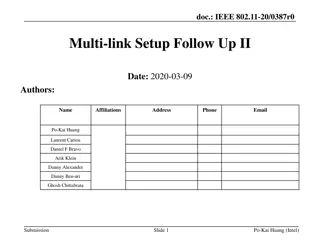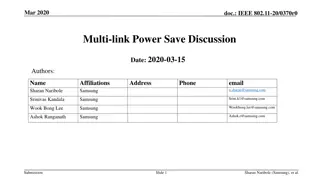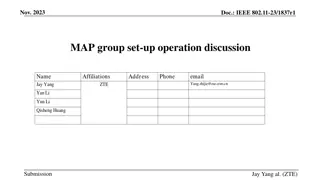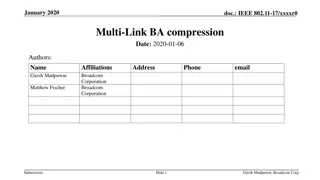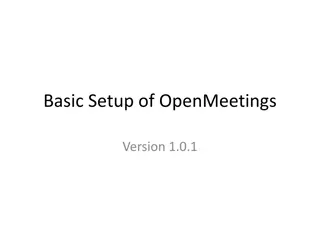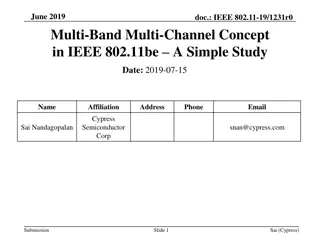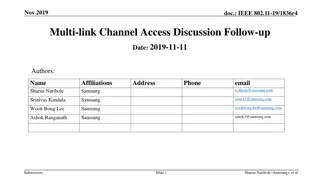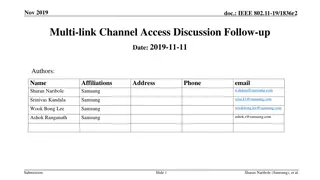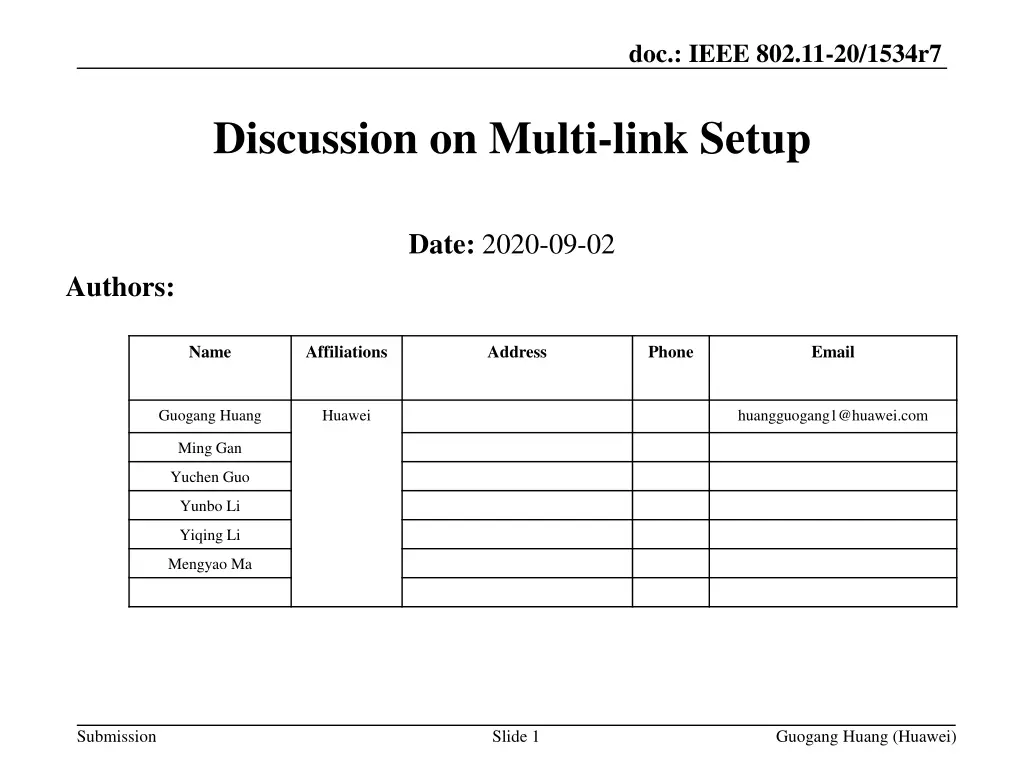
IEEE 802.11-20/1534r7 Discussion on Multi-link Setup
Learn about the consensus reached on enabling/disabling based on TID-to-link mapping in IEEE 802.11-20/1534r7. Explore scenarios, proposals, and considerations for multi-radio non-AP MLD setups presented by Guogang Huang from Huawei.
Download Presentation

Please find below an Image/Link to download the presentation.
The content on the website is provided AS IS for your information and personal use only. It may not be sold, licensed, or shared on other websites without obtaining consent from the author. If you encounter any issues during the download, it is possible that the publisher has removed the file from their server.
You are allowed to download the files provided on this website for personal or commercial use, subject to the condition that they are used lawfully. All files are the property of their respective owners.
The content on the website is provided AS IS for your information and personal use only. It may not be sold, licensed, or shared on other websites without obtaining consent from the author.
E N D
Presentation Transcript
doc.: IEEE 802.11-20/1534r7 Discussion on Multi-link Setup Date: 2020-09-02 Authors: Name Affiliations Address Phone Email Guogang Huang Huawei huangguogang1@huawei.com Ming Gan Yuchen Guo Yunbo Li Yiqing Li Mengyao Ma Submission Slide 1 Guogang Huang (Huawei)
doc.: IEEE 802.11-20/1534r7 Introduction The following consensus has been reached Enable/disable is govern by TID-to-link mapping. In other words, enable/disable is the result of TID-to-link mapping Note that frame exchange on a link is subject to the power state of the corresponding non-AP STA. [Motion 106, [30] and [235]] An AP MLD can recommend a non- AP MLD to use one or more enabled links. The AP s indication could be carried in a broadcast or a unicast frame. In this contribution, we seek to clarify how to signal the multi-link setup and link recommendation Submission Slide 2 Guogang Huang (Huawei)
doc.: IEEE 802.11-20/1534r7 Scenario Considered For the AP MLD, it has three links which respectively operates at 2.4 GHz, 5 GHz and 6 GHz For a multiple-radio non-AP MLD assume that it has two radios, one is only for the 2.4 GHz band, the other one is for either 5 GHz band or 6 GHz band. When the non-AP MLD requests to setup three links, then link 1 and link 2 will share a common physical STA, as illustrated in the below figure AP MLD AP1 2.4GHz AP2 5GHz AP3 6GHz link 0 link 1 link 2 Sharing a common radio STA1 STA2 STA3 Multi-radio Non-AP MLD Submission Slide 3 Guogang Huang (Huawei)
doc.: IEEE 802.11-20/1534r7 Proposal Optional subelements Element ID Extension Element ID (=255) Multi-Link Control Per-STA Profile y (if present) Length Field 1 Field k Per-STA Profile x ... Radio ID Status Code Power Link ID ... Subelement ID (=0) Management Length Data Per-STA Control field Fixed order for certain Fields / IEs (1 or more) Non-Inheritance element (if present) Element n+1 ... ... ... ... Element 2 Element n Element L Element Y Element order as defined in Beacon frame or Association Request frame Last element Submission Slide 4 Guogang Huang (Huawei)
doc.: IEEE 802.11-20/1534r7 Radio ID According to the following motion, a Radio ID subfield may be needed when a non-AP MLD has multiple affiliated physical STAs [Motion 106, [30] and [235]] An AP MLD can recommend a non-AP MLD to use one or more enabled links. The AP s indication could be carried in a broadcast or a unicast frame. If multiple Per-STA profiles have the same Radio ID, that means these links share a common physical STA. The Radio ID of STA transmitted (Re-)Association Request frame is 0 by default. The Radio ID also can be used in the following operations Giving more information to AP to decide the TID-to-link mapping at association time or later Change the STA-AP mapping at the association time or later [2]. Note when only one MAC address for a non-AP MLD is adopted by 11be group in the future [3], there is a need to distinguish affiliated STAs Submission Slide 5 Guogang Huang (Huawei)
doc.: IEEE 802.11-20/1534r7 Radio ID (Cont.) Example. Change the STA-AP mapping Assuming that AP MLD has three links, which respectively operates at 2.4 GHz (corresponding link 0), 5 GHz (corresponding link 1) and 6 GHz (corresponding link 2) Non-AP MLD has three switchable radios which can operate at 2.4 GHz, 5 GHz and 6 GHz, but with different capabilities Non-AP MLD AP MLD AP MLD Non-AP MLD Request to setup the following links: <Link 0, Radio 0>, <Link 1, Radio 1>, <Link 2, Radio 2> Request to setup the following links: <Link 0, Radio 0>, <Link 1, Radio 1>, <Link 2, Radio 2> Accept to setup the following links: <Link 0, Radio 0>, <Link 1, Radio 2> Accept to setup the following links: <Link 0, Radio 0>, <Link 1, Radio 2> <Link 2, Radio 1> Recommend to setup <Link 2, Radio 1> Case 1. Association time Case 2. After association time Submission Slide 6 Guogang Huang (Huawei)
doc.: IEEE 802.11-20/1534r7 Power Management and Capability Information The non-AP MLD can explicitly indicate the power management of each non-transmitting link after the multi-link setup Active mode Power save mode and its power state is doze by default This is helpful to reduce the latency of the delay-sensitive traffic when the non-AP MLD is roaming to a new AP MLD There are two options for the Capability Information indication Option 1. Capability Information is MLD-level Option 2. Capability Information is link-level But the values of some subfields in Capability Information field must keep consistent, e.g. ESS, IBSS, APSD subfields Submission Slide 7 Guogang Huang (Huawei)
doc.: IEEE 802.11-20/1534r7 Status Code In the current Spec., the AP MLD maybe accept or reject some requested links with one of the following Status Code values [4]: 0: SUCCESS 1: REFUSED_REASON_UNSPECIFIED 10: REFUSED_CAPABILITIES_MISMATCH 11: DENIED_NO_ASSOCIATION_EXISTS 12: DENIED_OTHER_REASON 17: DENIED_NO_MORE_STAS 18: REFUSED_BASIC_RATES_MISMATCH 19: DENIED_NO_SHORT_PREAMBLE_SUPPORT 22: REJECTED_SPECTRUM_MANAGEMENT_REQUIRED 23: REJECTED_BAD_POWER_CAPABILITY 24: REJECTED_BAD_SUPPORTED_CHANNELS 25: DENIED_NO_SHORT_SLOT_TIME_SUPPORT 27: DENIED_NO_HT_SUPPORT 30: REFUSED_TEMPORARILY 33: DENIED_INSUFFICIENT_BANDWIDTH 34: DENIED_POOR_CHANNEL_CONDITIONS 35: DENIED_QOS_NOT_SUPPORTED 51: DENIED_LISTEN_INTERVAL_TOO_LARGE 92: REFUSED_EXTERNAL_REASON 93: REFUSED_AP_OUT_OF_MEMORY 94: REJECTED_EMERGENCY_SERVICES_NOT_SUPPORTED 99: DENIED_WITH_SUGGESTED_BAND_AND_CHANNEL 103: DENIED_DUE_TO_SPECTRUM_MANAGEMENT 104: DENIED_VHT_NOT_SUPPORTED Most of them can be link-level. Submission Slide 8 Guogang Huang (Huawei)
doc.: IEEE 802.11-20/1534r7 Status Code (Cont.) Then the AP MLD needs to respectively indicate whether the requested link is set up successfully through a corresponding Status Code subfield If the transmitting link is rejected, then the association is considered failed If the transmitting link is accepted and all of non-transmitting links are rejected, then the STA-level association is considered successful If the transmitting link is accepted and at least one of non-transmitting links is accepted, then the MLD-level association is considered successful Power ... Link ID Radio ID Status Code Management Per-STA Control field Fixed order for certain Fields / IEs (1 or more) Non-Inheritance element (if present) Element n+1 ... ... ... ... Element 2 Element n Element L Element Y Element order as defined in Beacon frame or Association Request frame Last element Submission Slide 9 Guogang Huang (Huawei)
doc.: IEEE 802.11-20/1534r7 Link Recommendation AP MLD can send a Link Recommendation notification to the non- AP MLD through one link, which includes the following info Recommended link ID Change Sequence of the recommended link ID (optional) Reason code e.g. overload, low RSSI, traffic steering and so on When the Change Sequence value is different from the locally stored Change Sequence value of the recommended link, the non- AP MLD may send a Probe Request frame with the locally stored Change Sequence in the recommended link Then AP MLD may reply a Probe Response frame with the corresponding elements whose contents are changed Submission Slide 10 Guogang Huang (Huawei)
doc.: IEEE 802.11-20/1534r7 Conclusion We discussed how to signal the Multi-link setup and enable fast link transition. We prefer the links to be setup to be explicitly indicated by inclusion the corresponding Per-STA Profile subelement. We also proposed that the non-AP includes information of Radio ID in the Per-STA Profile subelement to help the indication of which links sharing a common STA We also proposed that the non-AP/AP MLD indicates the Power Management for the non-transmitting link in the Per-STA Profile subelement We also proposed that the AP MLD decides whether or not to accept the setup of each non-transmitting link through Status Code in the Per-STA Profile subelement Submission Slide 11 Guogang Huang (Huawei)
doc.: IEEE 802.11-20/1534r7 SP 1 Do you support that A non-AP MLD with more than one affiliated STA includes a Radio ID field in the Per-STA Profile subelement of a multi-link element included in Association Request frame? Submission Slide 12 Guogang Huang (Huawei)
doc.: IEEE 802.11-20/1534r7 SP 2 Do you support that an AP MLD separately signals whether to accept each request link through a Status Code field in the corresponding Per-STA profile? Submission Slide 13 Guogang Huang (Huawei)
doc.: IEEE 802.11-20/1534r7 SP 3 Do you support to indicate the Power Management for each non-transmitting link after the multi-link setup as following? Active mode Power save mode and its power state is doze by default Submission Slide 14 Guogang Huang (Huawei)
doc.: IEEE 802.11-20/1534r7 Reference [1] 11-20-1274-02-00be-mac-pdt-mlo-ml-ie-structure.docx [2] 11-20-1554-01-00be-ml-reconfiguration.pptx [3] 11-20-1890-00-00be-reconsideration-on-sta-mac-address-of-non-AP-mld.ppt [4] IEEE 802.11 Rmd 5.0 Submission Slide 15 Guogang Huang (Huawei)

